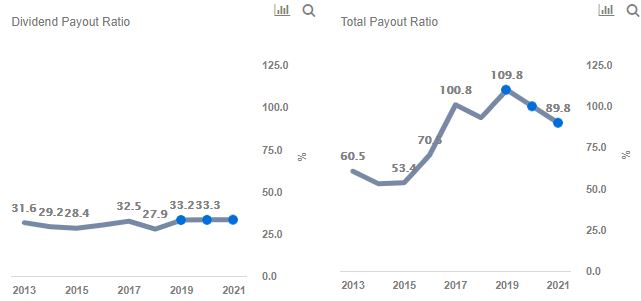JPMorgan Will Return A Record $40 Billion To Shareholders In The Next Twelve Months
JPMorgan Chase (NYSE:JPM) announced its intention to return $40.4 billion to its shareholders over the next twelve months as part of its latest capital return plan released last week – making it the largest-ever capital return plan in the history of the diversified banking giant. In fact, the plan dwarfs the previous record for investor payouts by any U.S. bank over a 12-month period set by Wells Fargo last year with its $32.8 billion capital plan.
Trefis has analyzed the trends in JPMorgan’s dividend payouts and share repurchases over the last 5 years and has summarized our expectations for the next three. You can modify Trefis forecasts to see the impact any changes would have on the JPMorgan’s share repurchase and dividends using our Interactive Dashboard. Additionally, you can find more Trefis data for financial services companies here.
JPMorgan’s Capital Return Plan (2019)
- Under the new plan, JPMorgan will hike its quarterly dividends by 12.5% – from 80 cents now to 90 cents a share beginning Q3 2019. This works out to total dividends of $11 billion assuming average outstanding shares of 3.1 billion for the next twelve months.
- The bank will also repurchase $29.4 billion worth of its common shares over this period.
- The latest capital return plan of $40.4 billion over Q3 2019-Q2 2020 represents a 28% jump compared to the $31.5 billion in dividends and share repurchases JPMorgan announced in 2018.
The chart below details JPMorgan’s total shareholder payouts for each year since 2013, and includes our forecast for the next three years.
Historical Payouts
- JPMorgan has been fairly liberal with its policy of returning cash to investors over the years.
- The banking giant paid 34 cents in quarterly dividends for more than six years (Q2 2001 to Q2 2007), until it revised it upwards to 38 cents in the third quarter of 2007 – only to slash it to 5 cents in Q2 2009 in the wake of the economic downturn.
- The bank hiked dividends five-fold to 25 cents in Q2 2011, and has gradually increased this figure over the years to reach 80 cents per share in 2018.
- The dividend figure will now increase to 90 cents per share over Q3 2019 – Q2 2020.
- JPMorgan has paid out at least $2 billion to investors each year since 2005 despite the economic downturn of 2008, with the figure reaching $28.5 billion in 2018.
- Over the last ten years, the bank has returned $124.1 billion in cash to common shareholders, an average of $12.4 billion a year – representing about 63% of its average retained earnings of $19.7 billion for this period.
- The total dividend payout over this period has been roughly $50.9 billion, while share buybacks have cost the bank $73 billion.
- While it would appear that JPMorgan prefers share repurchase to dividends from this data, it must be remembered that share buybacks have been significantly higher than dividends the last couple of years.
What To Expect In 2019
- We expect total dividends to be around $10.6 billion, as the annual dividend per share will increase to $3.43 from $2.52 in 2018. Also, the bank has repurchased $5.1 billion in shares in Q1 2019 and should have repurchased $5.3 billion in shares over the second quarter (remaining share buyback out of $20.7 billion approved in the 2018 capital return plan).
- Taken together with $14.7 billion in proposed purchases for the rest of the year (half of the total proposed repurchases of $29.4 billion), total share repurchases is expected to be around $25 billion in 2019. This will be the biggest share buyback by JPMorgan for any year.
- The total payout for the year is, therefore, likely to be over $35.9 billion – exceeding our forecast for the bank’s net income of $32.7 billion. This should also make 2019 the best year for JPMorgan’s investors in terms of total payout, as it easily surpasses the $28.5 billion in dividends and buybacks in 2018.
We factor in these payouts in our analysis of JPMorgan in the form of an adjusted dividend payout rate (which is the total payout ratio), shown in the chart below.
Do not agree with our forecast? Create your own forecast for JPMorgan Chase by changing the base inputs (blue dots) on our interactive dashboard.
What’s behind Trefis? See How It’s Powering New Collaboration and What-Ifs
For CFOs and Finance Teams| Product, R&D, and Marketing Teams
All Trefis Data
Like our charts? Explore example interactive dashboards and create your own


